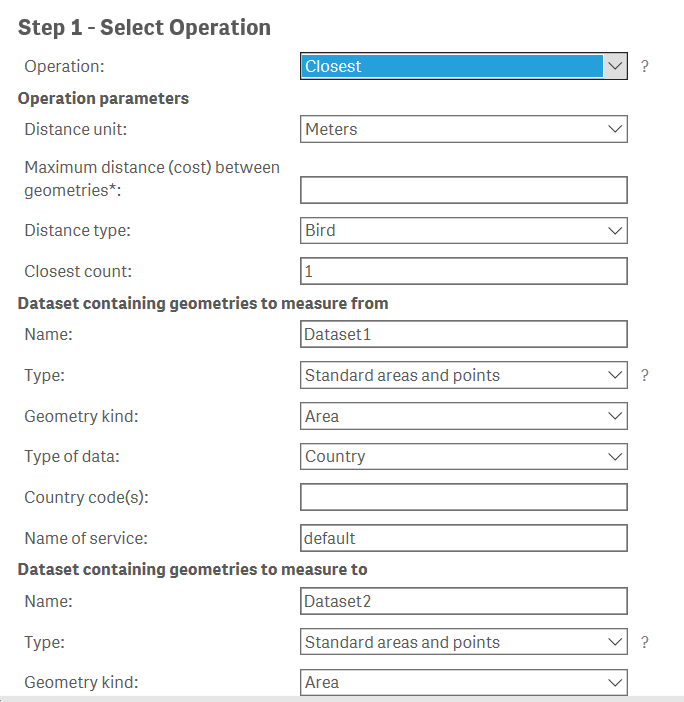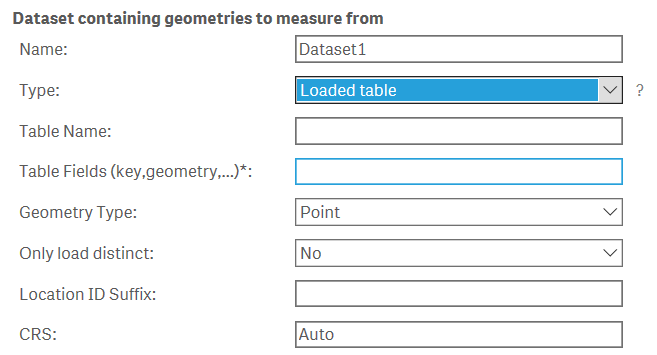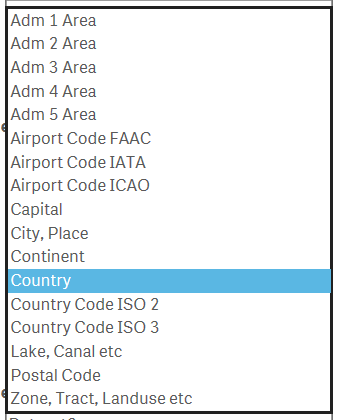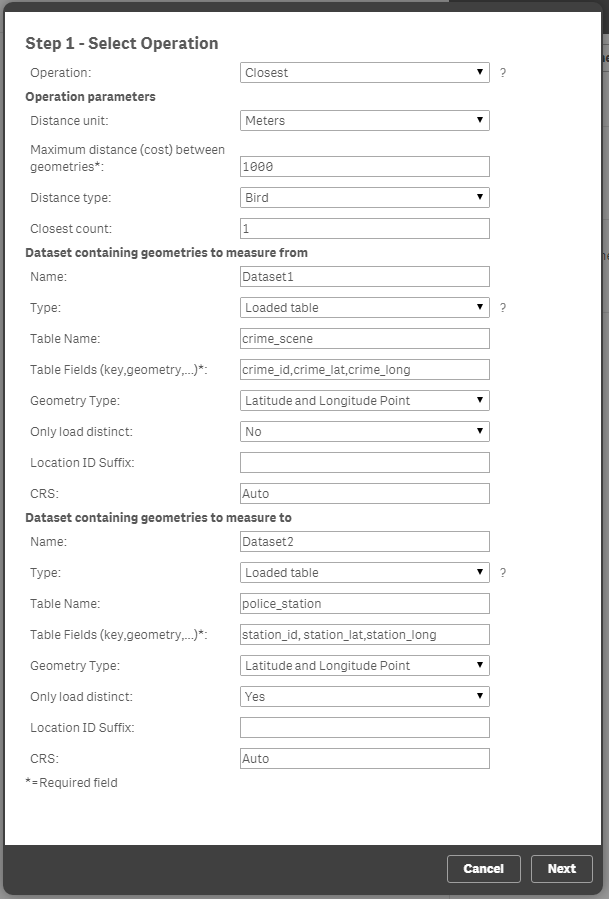Unlock a world of possibilities! Login now and discover the exclusive benefits awaiting you.
- Qlik Community
- :
- All Forums
- :
- GeoAnalytics
- :
- Help Using GeoAnalytics Connector with Your Own Da...
- Subscribe to RSS Feed
- Mark Topic as New
- Mark Topic as Read
- Float this Topic for Current User
- Bookmark
- Subscribe
- Mute
- Printer Friendly Page
- Mark as New
- Bookmark
- Subscribe
- Mute
- Subscribe to RSS Feed
- Permalink
- Report Inappropriate Content
Help Using GeoAnalytics Connector with Your Own Data
I've been spending a good amount of time trying to learn GeoAnalytics. I've come to understand that while the extensions for the maps are great, the real power is in the Connector and the functions the wizard makes available. Best I can tell, the connector sends your data to the Idevio servers, where it is processed for the functions you would like to return, and then loads a table of data results to your Qlik Sense application for utilization by the maps.
So I have been playing with the samples here:
Guides & Examples « bi.idevio.com
Unfortunately, I cannot really figure out how to use my own data, primarily because I'm unable to figure out what the input values are that the wizard is expecting. Take the 'closest' example:.
I have two excel data files. One contains Lat/Long coordinates for Crimes that have occurred, and I load it into Qlik Sense named 'Crime'. The second file contains Lat/Long coodinates for Police Stations that exist, and I load it in names "Stations".
I then go into the GeoAnalytics Connector and open it up. That gives me this screen:

So the 1st section is pretty straight-forward. For the two Datasets, I believe I put "Crime" is as the Name. The Type is the 1st confusing item. From my investigation, I think the "Standard areas and points" just uses sample data from Idevio, and thus leaving this as the option would NOT use my Lat/Long data. So I think I need to change this. Here are the options:

The option that seems to make the most sense is "Loaded table". Switching to this gives me these options:

So for the table name, I believe I would use the name of the table defined in the data load editor:

So I enter "Sheet1" as the Table Name. But the table name input is the next confusing piece. Do I enter the 4 columns in this table? Or is it specifically looking for things like key, geometry? Aren't these the values that the server will send BACK to me as output? Doesn't GeoAnalytics take my data, fine the closest points, and create a table I can then use for the mapping? I am confused on this data entry point. I haven't been able to make this piece work yet to actually return true closest values...I am stuck.
Not to further confuse all of this, but many of the functions ask for the "Type of Data", which gives these options:

What do the 1st 5 areas mean? Why is there no Lat/Long as an option here? There also is no street address option. This is also confusing.
Sorry for the long post, but could REALLY use help if anyone knows how this works. Thank you!
- « Previous Replies
-
- 1
- 2
- Next Replies »
- Mark as New
- Bookmark
- Subscribe
- Mute
- Subscribe to RSS Feed
- Permalink
- Report Inappropriate Content
Was this from the webcast? I downloaded the Idevio GeoAnalytic package but haven't tried it yet.
Tom
- Mark as New
- Bookmark
- Subscribe
- Mute
- Subscribe to RSS Feed
- Permalink
- Report Inappropriate Content
Check your data load script against the options you're giving the connector. Unless they're for example... they don't seem to match. Not an expert but learning.... just trying to help,
Tom
- Mark as New
- Bookmark
- Subscribe
- Mute
- Subscribe to RSS Feed
- Permalink
- Report Inappropriate Content
If I am understanding GeoAnalytics correctly, the issue isn't what is in my script. Rather, I need to better understand the input that the Idevio servers are expecting in order to calculate the geo functions.
- Mark as New
- Bookmark
- Subscribe
- Mute
- Subscribe to RSS Feed
- Permalink
- Report Inappropriate Content
Hello,
If I understand your issue correctly, you want to load in your own data and use it with the map?
If you have a file which already contains Lat/Long then there is no need to use the connector. Instead you load in the data and plot the coordinates using bubble layer with Lat/Long from your Excel file.
The picture you show above with adm1- adm5 etc. is if you want to use already existing lookup services from an internal database.
If you want to make a relation between the two files by then you could use the connector. But to do an operation like Closest point you should first load the data from the files into two different tables. After that you follow the instruction the connectors requires. It could look like the image i attached below.
Dataset containing geometries to measure from: Is the data you want to iterate over, in this case which police station is the closest to the place of the crime.
Type: Is where the data coming from.
Table name: The name of the table that contains the data.
Table Fields: The fields in the table you want to include.
Geometry Type: which type of data it is. 
Please do not hesitate to ask more questions and if you are not able to sort it out, then you could send me some sample data and I can help you with the application.
Best Regards,
Alexander Jaballah
- Mark as New
- Bookmark
- Subscribe
- Mute
- Subscribe to RSS Feed
- Permalink
- Report Inappropriate Content
Thank you! My issue was I was entering the columns from the tables in order, it appears the wizard specifically wants the ID field and then Lat, Long.
- Mark as New
- Bookmark
- Subscribe
- Mute
- Subscribe to RSS Feed
- Permalink
- Report Inappropriate Content
Here is a guide I put together that details many of the operations available through Qlik GeoAnalyitcs, and how the data needs to be added to the various wizards.
- Mark as New
- Bookmark
- Subscribe
- Mute
- Subscribe to RSS Feed
- Permalink
- Report Inappropriate Content
why do you set Only Load Script as yes in the dataset2 ?
- Mark as New
- Bookmark
- Subscribe
- Mute
- Subscribe to RSS Feed
- Permalink
- Report Inappropriate Content
I followed step by step but when im trying to load data via Data Load Editor I get:
Started loading data
Connected
The following error occurred:
The error occurred here:
For n = 0 to chunks
Data has not been loaded. Please correct the error and try loading again.
What does this mean?
- Mark as New
- Bookmark
- Subscribe
- Mute
- Subscribe to RSS Feed
- Permalink
- Report Inappropriate Content
I get the exact same error message ("For n=0 to chunks").
Have you found a solution?
- « Previous Replies
-
- 1
- 2
- Next Replies »